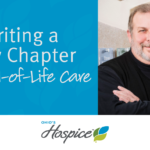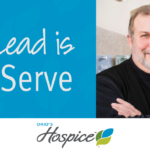
Ohio’s Hospice: Doing What’s Right
by Kent Anderson, President/CEO
Remember the game musical chairs? A chair is taken away and everything changes—but no one realizes it until the music stops.
Over the last decade, I’ve watched the healthcare landscape change dramatically. To stay competitive, hospitals across the nation are consolidating in record numbers.

They are focused on making sure that when the music stops, they don’t find themselves without a chair. Or perhaps even worse, find themselves sitting in a chair next to partners they don’t like—or trust.
Of course, the changing healthcare landscape isn’t just impacting hospitals. It also is spurring other healthcare organizations, including hospices, to assess their options, too.
It’s about relevance
During these changing times, many non-profit hospices are asking the question: “How can we stay sustainable?”
At Ohio’s Hospice, our focus has been instead: “How can we stay relevant?”
That’s why we created an alliance with other non-profits across Ohio—from southwest to central Ohio—who share our same mission. This new organization, Ohio’s Hospice, has an intense focus on providing:
- quality care for our patients
- strong support our patients’ families
- resources, education and backing for all of the physicians, nurses and dedicated teams that make the critical work we do happen each and every day
By joining forces, we can maintain our deep commitment to mission-driven work and serve more patients and their families.
Our hospices are able to share administrative costs, such as accounting, finance, compliance and HR. Because nobody started a hospice thinking, “My big goal is to have the best billing department.”
As the regulatory landscape squeezes hospice budgets, we realized we could either cut costs or share costs.
Sharing administrative burdens means Ohio’s Hospice can spend more of our money where it matters most, ensuring:
- the hospice workers who care for you and your family come from your community
- you have the doctors who specialize in end-of-life care, and therapists and clergy who are there for you
- that we can pay attention to the details that matter—like 24/7 room service delivery and light, plant-filled rooms that seem a lot less like institutions and a lot more like home
As budgets tighten, and the music slows down, the goal of Ohio’s Hospice is not only to have a chair. It’s to be sitting with strong partners who understand that hospices should not be about making money. They should be about making lives better—for patients, for families, for all of us who want to make end-of-life care a deeply caring experience.
Author Profile
Latest entries
 ExpertiseFebruary 20, 2018The Three Words That Will Change Your Life
ExpertiseFebruary 20, 2018The Three Words That Will Change Your Life Thought LeadershipJanuary 17, 2018Writing A New Chapter for End-of-Life Care
Thought LeadershipJanuary 17, 2018Writing A New Chapter for End-of-Life Care News and UpdatesDecember 8, 2017To Lead is to Serve
News and UpdatesDecember 8, 2017To Lead is to Serve ExpertiseNovember 28, 2017Why Choosing a Not-for-Profit Hospice Makes a Difference in Patient Care
ExpertiseNovember 28, 2017Why Choosing a Not-for-Profit Hospice Makes a Difference in Patient Care

